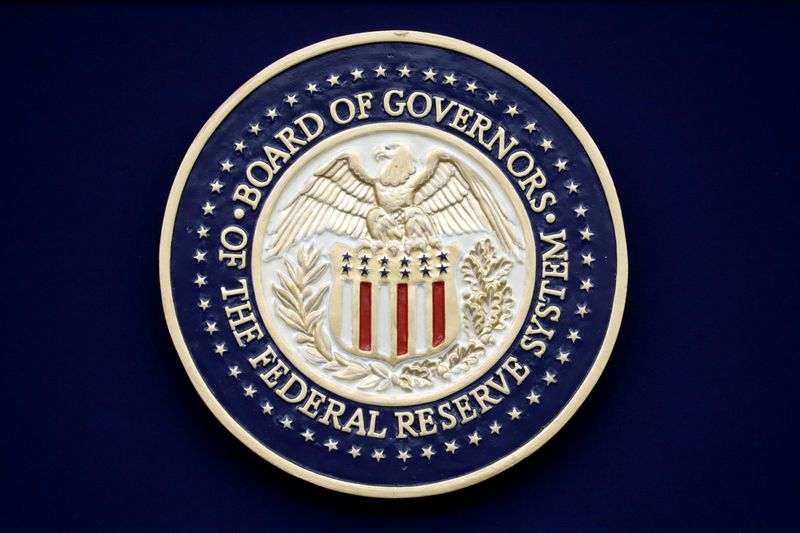LONDON/NEW YORK (Reuters) – The dollar drought has turned into a flood, the Fed has cut interest rates to 0% and pumped $2 trillion into world markets, – but what if this immense stimulus wave is responsible for supporting rather than weakening the greenback?
An index measuring the dollar’s value against a basket of six currencies has eased 3% since mid-March but is still on track for a fourth straight month of gains <=USD> And a trade-weighted index remains at three-year highs in a Fed index.
Essentially, markets have shrugged off a surge in dollar supply from the Federal Reserve, rising U.S. public debt, the economic hit from the coronavirus pandemic and, above all, shrinking yield premiums over other currencies — 10-year U.S. debt now pays 1% over the euro equivalent for instance, half the spread prevailing in February.
Despite the vanishing yield premiums, the dollar index soared 8.5% in under three weeks during March — the biggest rise in such a short interval since 2008 — as investors stampeded for the world’s safest and most widely used currency.
But markets have since calmed and the dollar is no longer a scarce commodity, according to dollar pricing in global cross-currency swaps markets.
Many see this resilience as temporary, citing improving risk sentiment and smaller balance sheet expansion elsewhere. Yet the very size of the Fed’s stimulus, and its effect compared to Europe’s and Japan’s, could be a source of strength for the dollar.
Researchers said that when quantitative easing was first used in 2008, the dollar was boosted by the confidence effect – a more expansive policy was seen as driving faster economic recovery.
It is from that playbook that the Fed has borrowed.
In the last two months, the balance sheets of the 10 biggest central banks expanded by $3.7 trillion, an amount roughly equal to the sum of their assets before the 2008 crisis, Deutsche Bank estimates.
The Fed accounted for over half that increase, increasing its balance sheet by half, but far from weakening the dollar, it did the opposite.
The European Central Bank and the Bank of Japan contributed 20% each, but their currencies declined.
(Graphic: G10 central bank balance sheets IMAGE link: https://fingfx.thomsonreuters.com/gfx/mkt/yzdvxoolbpx/Pasted%20image%201588081377948.png)
“The Fed appears to be working under the premise that in past crises of historic proportion, there are almost no occasions when monetary authorities are remembered and accused of doing too much,” said Alan Ruskin, chief international strategist at Deutsche Bank.
“So why not load the bazooka with the kitchen sink and go nuclear?”
He said stimulus elsewhere has often been viewed as a sign of weakness or, at worst, pulling the same policy levers multiple times.
Notably, between June 2014 and March 2015, the ECB expanded its balance sheet to 25% of GDP. In response, the euro sank 25%.
(Graphic: G3 + China central bank balance sheets IMAGE link: https://fingfx.thomsonreuters.com/gfx/mkt/qmypmnoybvr/Pasted%20image%201588157623768.png)
DIFFERENT BAZOOKAS
Deploying big policy action seems to yield different results in the United States, where demographic and labour force strengths can drive a swift rebound in credit demand.
That leads markets to look ahead to recovery, rather than worry about the immediate effects on the currency.
To illustrate the difference, consultancy BCA Research estimates the running three-month increase in three-month U.S. bank credit at $800 billion compared to the “underwhelming” euro area total of $280 billion.
So if focus is shifting to future growth, the U.S economy appears in pole position; it is seen contracting less and rebounding quicker than its rivals.
“Currency and equity markets have sensed this and are, in my view, pricing in a prospective U.S.-led economic recovery,” Stephen Jen, co-founder at hedge fund Eurizon SLJ, said.
Howard Wang, co-founder of New York-based Convoy Investments LLC noted also that a shrinking trade deficit may benefit the dollar — in 2008 the deficit shrank by 62%, Fed data shows.
(Graphic: U.S. trade deficit with China IMAGE link: https://fingfx.thomsonreuters.com/gfx/mkt/azgpombwwpd/Pasted%20image%201588082488391.png)
BEARS VS BULLS
The outcome of Wednesday’s Fed meeting held out the promise of more easing and markets are watching to see if that changes the equation for the dollar in the longer term. On Thursday, the Fed widened a key program to more firms.
There are of course plenty of dollar bears out there — Morgan Stanley strategists note the trade-weighed dollar peaked on March 23, when U.S. financial conditions were tightest — the same pattern as 2008.
If growth recovers as fast as it collapsed, “demand for dollars should subside from current extreme levels”, they added.
Two issues complicate that picture.
One is continued emerging market stress; hits to exports and investment, alongside debt repayment needs is keeping dollar demand high in the developing world, according to FX swap pricing in the Turkish lira and Russian rouble <TRYCBS1Y=> <RUBCBS1Y=>.
Another is the euro zone, which remains over-reliant on the ECB to provide stimulus and rescue weaker member states. While governments are finally stumping up a whopping 3.2 trillion euros, their failure to pool the bloc’s risks in a joint bond saps confidence in the euro, according to economists.
European policymakers need to either issue joint bonds or unveil an even bigger rescue package, said Anna Stupnytska, economist at Fidelity International.
That is what would brake the euro’s slow descent and lay the foundations for a longer-term dollar decline, she added.
(Graphic: Even as Fed cuts rates, dollar stays king IMAGE link: https://fingfx.thomsonreuters.com/gfx/mkt/xlbvgngropq/Pasted%20image%201588083781963.png)
(Reporting by Saikat Chatterjee and Saqib Ahmed in New York; Graphics by Ritvik Carvalho; Editing by Sujata Rao and Frances Kerry)



















